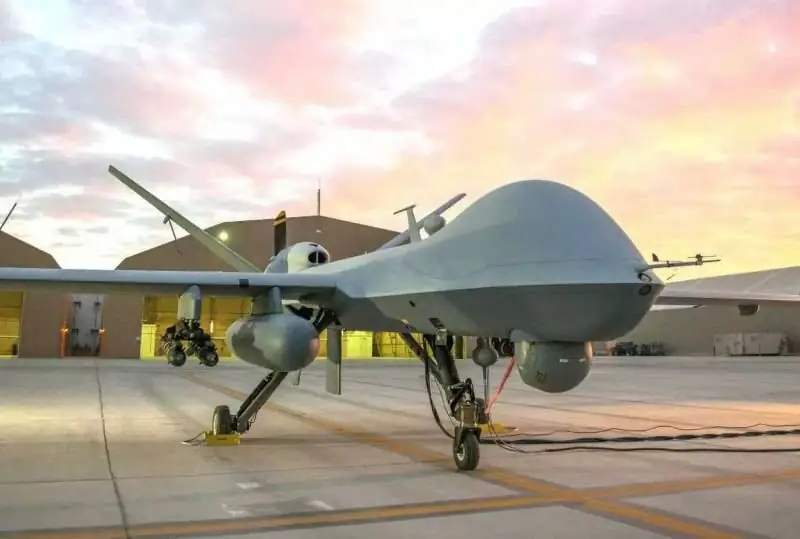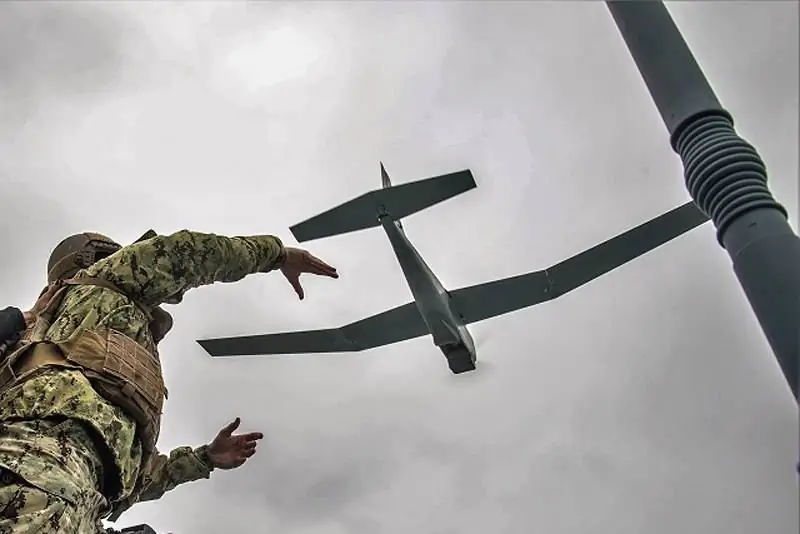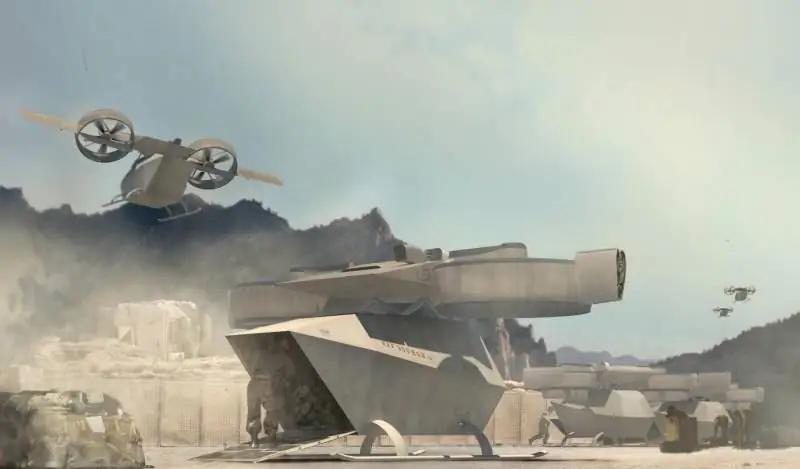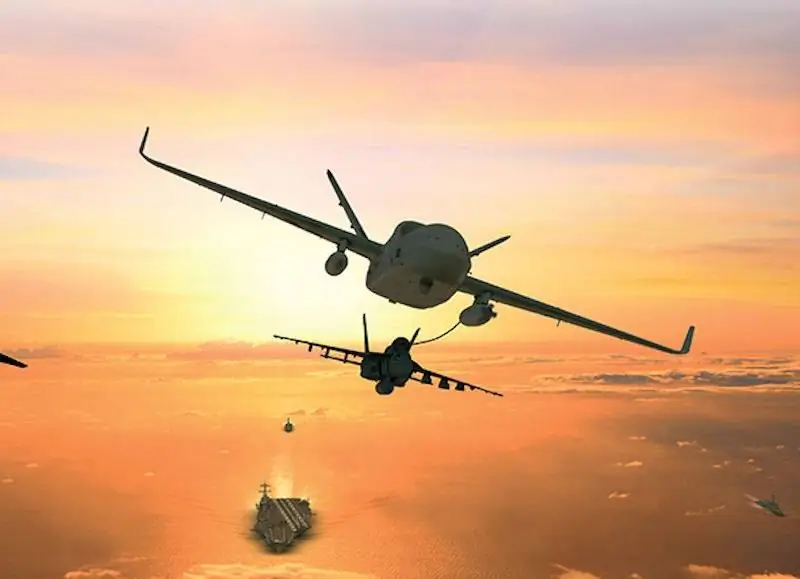- Author Matthew Elmers [email protected].
- Public 2023-12-16 21:49.
- Last modified 2025-01-24 09:17.

Unmanned freedom
Analyst company Teal Group predicts a significant increase in the production of unmanned aerial vehicles (UAVs), due to their widespread adoption and a sharp increase in demand for next-generation attack UAVs in the next 10 years or so.
In its latest market research, published in November 2017, the company estimates an increase in annual production of UAVs from $ 4.2 billion (hereinafter, if not specified, all financial indicators are in dollars) in 2017 to $ 10.3 billion. In 2026, with total expenditures for this period of about 80.5 billion, while spending on military research in this sector will increase this figure by another 26 billion.
“Increased demand for long-range high-altitude systems, for armed UAVs, the development of next-generation combat unmanned systems and new areas such as missile defense continue to drive the market,” said Philip Finnegan, co-author of the Teal Group study.
Study co-author Steve Zaloga said they expect the US to spend 57 percent of all global spending on research, development, and testing of these technologies and roughly 31 percent of global military drone purchases. He added that the relatively large numbers are due to the focus on large, expensive systems in the US market, although growth in other regions, such as the Asia-Pacific, is faster. In its April global market survey, Global Market Insights (GMI) estimates are largely in line with Teal's expectations. She estimates the global market size in 2016 at 5 billion, but expects the annual market volume to reach 13 billion sooner, in 2024. Although military UAV fleets are growing around the world, the United States still operates 70 percent of the total number of vehicles. According to GMI, military orders brought the industry over 85 percent of total revenues in 2016, and the sale of helicopter-type UAVs in the same year brought more than 65 percent of the industry’s total revenues.

Explosive growth
GMI projects a compound annual growth rate (CAGR) of more than 12 percent from 2017 to 2024 and a fleet size of more than 18,000 units by the end of this period, although it is not clear what “pieces” means, a single vehicle or unmanned systems, which may include several devices. As for the Asia-Pacific region, the market is expected to show a CAGR of about 17 percent over the same period.
Other expected trends include a CAGR of the hybrid UAV market (a combination of vertical takeoff and landing with horizontal flight) of more than 15 percent and a CAGR of the autonomous UAV market of over 18 percent, according to GMI.
The attractiveness of vertical take-off and landing is obvious, especially if the vehicles can take off and land automatically, since it becomes easier to work with UAVs in confined spaces and from hidden positions, the process of launching and returning is simplified, a smaller area is required, etc. However, as in the case of manned aircraft, vertical take-off and landing always limit speed, flight range and carrying capacity.
Hybrid solutions of various types are entering the market, many of which combine a propeller driven by an internal combustion engine for cruising and four or more vertically mounted propellers for vertical flight modes. More advanced and complex designs use solutions such as swing wings, tilt push or pull propellers, or even tail landings to minimize the loss of payload due to the addition of an additional propulsion system that is not used in most applications.
The concept of "autonomous UAV" is a little vague, however, most of the devices produced today have one or another level of autonomy, can fly on pre-programmed routes, following intermediate points, and automatically use emergency modes, for example, in case of loss of communication or battery discharge. In doing so, more advanced capabilities are being developed, such as collision detection and avoidance, group flights and task sequencing. Autonomy, the report says, is becoming an increasingly important factor in market development.
Focus out of line of sight
The study also predicts that in the period under review, drones capable of operating at ranges beyond line-of-sight will occupy more than 67 percent of the market, and vehicles with a maximum take-off weight of 25 to 150 kg will capture more than half of the market. The importance of larger UAVs will also increase; over the period under review, a CAGR of about 11 percent is expected for vehicles with a carrying capacity of 150 kg or more.
While the tasks of UAVs belonging to state military structures are reduced mainly to reconnaissance, observation and information gathering, armed reconnaissance and other combat missions, non-state actors, for example, the Islamic State (banned in the Russian Federation), have successfully adapted commercially available drones for dropping mortar mines, modified grenades and other improvised ammunition.
The importance of UAVs in reconnaissance missions continues to grow in parallel with advances in sensor technology, from optoelectronics to information gathering and support by radar and electronic means, and with the improvement of machine learning and artificial intelligence algorithms, which helps operators and analysts to extract the necessary information from the huge data stream and, as a result, it makes it easier for commanders to make decisions.
Increased attention has begun to be paid to the tasks of protecting borders and ensuring security, many countries continue to militarize their borders in order to contain possible migrants and refugees and terrorists and criminals that have lurked among them. For the above reasons, the importance of maritime patrolling is also growing, in addition to the more traditional need to protect the wealth of their exclusive economic zones.
Extensive patrol areas and missions lasting many hours contribute to the growing popularity of UAVs of the HALE (High Altitude Long Endurance) and MALE (Medium Altitude Long Endurance) categories, which are approaching size manned aircraft. However, there is also an increase in popularity in the sector of small-sized devices, a prominent representative of which is the Black Hornet nano-UAV from FLIR Systems. This palm-sized rotary-wing mini-apparatus has a range of 2 km and a flight duration of 25 minutes, which is enough for dismounted infantry or special forces to look around the corner, into the room or over the nearest hill.
Logically group
Between the extreme members - UAVs of the HALE category, for example, the Global Hawk, and nanodevices of the Black Hornet type - there are other categories (from small to large): mini, small-sized tactical, tactical MALE plus, in their own categories, ship-based vertical take-off and landing systems and experimental shock UAV. While these categories are used by the American industry, in parallel, the military has always had its own systematics, which, as a rule, was based on a "rank" system, but was changed to a system of five groups based on a combination of maximum take-off mass (MVM), operating altitude and speed.
Group 1 includes vehicles with MWMs up to 20 lb (9 kg) and operating altitudes up to 1200 feet (366 meters) above ground level, that is, nano-, micro- and mini-UAVs. An example is the Raven and Wasp drones from AeroVironmerit.
For Group 2, the relevant figures are: 21-55 lb (9.5-25 kg), 3500 feet (1067 meters) and speeds up to 250 knots (463 km / h); example, Boeing Insitu's ScanEagle.
Group 3 includes UAVs comparable to AAI's RQ-7B Shadow, Boeing Insitu's RQ-21B Blackjack, and NASC's RQ-23 Tigershark, weighing 55 to 1,320 pounds (599 kg), operating altitudes up to 18,000 feet (5,500 meters), and more. the same speeds as UAVs from Group 2.
Group 4 includes vehicles over 1,320 lb (599 kg), but with the same operating heights as Group 3 vehicles, but no speed limits. Group 4 includes, for example, MQ-8B Fire Scout from Northrop Grumman. MQ-1A / B Predator and MQ-1C Gray Eagle from General Atomics.
Finally, Group 5 UAVs weigh over 1,320 pounds and typically fly above 18,000 feet at any speed. These include the MQ-9 Reaper from General Atomics, the RQ-4 Global Hawk, and the MQ-4C Triton from Northrop Grumman.
Drone spending
The US is increasing its spending on all types of uninhabited systems and related technologies, but air systems so far dominate the Defense Department's fiscal 2019 budget request. The ministry is requesting approximately $ 9.39 billion, which includes funding for nearly 3,500 new uninhabited air, land and sea vehicles, up from $ 7.5 billion allocated for 2018.
In the request for 2019, 6.45 billion is requested for UAV systems, 982 million for maritime systems, 866 million will be allocated for technologies related to autonomous capabilities, including group flights, and, finally, 429 million will be allocated for ground vehicles. Recognizing the capabilities of potential and real adversaries, the ministry also wants to spend over a billion dollars on anti-drone technology, including a ship's laser.
The report, published by the UK Drone Research Center, highlighted the funding request for 1,618 Switchblade ammunition from Aero Vironment. The Switchblade loitering ammunition blurs the lines between UAVs and guided missiles. It also notes that funding for the MQ-9 Reaper drone program retained the status of the line with the largest amount in the request, which increased by more than 200 million to 1.44 billion, and that the allocation of more than $ 500 million for R&D of the carrier-based tanker drone The MQ-25 Stingray is the largest single increase in Department of Defense spending on unmanned systems. The report also notes that the Pentagon has requested additional funding for the artificial intelligence work known as Project Maven, as well as funding for new research in autonomy and artificial intelligence.
The sharp increase in the number of unmanned systems, as already mentioned, is not entirely the merit of the American military. For example, India has launched a tender for the purchase of 600 mini-UAVs for infantry battalions serving on the borders with Pakistan and China.
In its report, GMI noted that China has captured more than half of the UAV market in the Asia-Pacific region, driven by large investments by the Chinese government, which is focusing on expanding its own research, development and production. The production of the CH-5 Rainbow system is two times cheaper than the almost similar American MQ-9 Reaper.
Dumb, dirty and dangerous missions remain the bread and butter of UAVs, but the scale of these missions is expanding as the military of many countries strives to expand the boundaries of their capabilities.

Promising destinations - you've never seen anything like this
There is an old adage that new technologies will inevitably begin to be used in ways that their inventors and developers never imagined. This undoubtedly applies to drones as well. Many military personnel who have gained the opportunity to get to know them better find better ways to use them in order to increase the level of safety of themselves and their colleagues, as well as the level of command of the situation. The number of cases when soldiers go on a mission "blindly" is now sharply decreasing.
One of the obvious ways to find new challenges for UAV technologies is to provide these technologies to the military, after a while ask them to come up with ideas and experimentally test the proposed solutions.
Unplanned tasks
Sometimes new roles and tasks for UAVs arise from the awareness of inequality of opportunities, which must be leveled as soon as possible, in connection with which the direction of the main development program is radically changing. This is what happened with the MQ-25 Stingray carrier-based tanker of the American fleet, which, according to the UCLASS program (Unmanned Carrier-Launched Airborne Surveillance and Strike), was originally developed as a reconnaissance and / or strike platform. The new F-35 Lightning II fighter does not have enough range without refueling so that aircraft carriers can stay out of the range of modern weapons systems, such as advanced anti-ship missiles, increasingly deployed by such potential adversaries as China and Russia. The new MQ-25 stealth aircraft could replace existing tanker aircraft, which are not stealthy enough to get close to enemy air defense systems. This will allow the F-35 fighter to extend its range to strike deep into enemy defenses.
In February 2016, the US Navy announced its decision to replace the UCLASS program with the CBARS (Carrier Based Aerial Refuelling System) program, which will create a Hornet-sized refueling tanker with some reconnaissance capabilities. All other tasks foreseen by the UCLASS project, including drums and a communication repeater, were postponed for a possible future option. In July 2016, the drone received the designation MQ-25 Stingray.
As a result of the analysis of inequality of opportunities, another new task for UAVs was identified, although not new for manned aviation. This is an airborne early warning radar (AWACS) for tactical groups of ground forces and aviation of the Marine Corps MAGTF (Marine Air Ground Task Force), which do not have the support of an aircraft carrier strike group and early detection aircraft E-2D Hawkeye. In the future, it is not excluded that MAGTF groupings will operate in a difficult combat situation without the support of an aircraft carrier in such tasks as distributed maritime operations, coastal operations and expeditionary operations.

Airborne long-range radar detection
In this regard, AWACS was identified as a top priority task for the MUX program (MAGTF UAS Expeditionary - an expeditionary unmanned aerial vehicle for the MAGTF grouping). Other top priority tasks include reconnaissance and surveillance, electronic warfare and relaying communications, while offensive air support is viewed as a second priority task, which can be unarmed, consisting in issuing target coordinates for targeting weapons launched from other platforms. Cargo escorting and transportation have been removed from the task list for this conceptually new VTOL / VTOL UAV project.
A system with similar characteristics is simply designed to work with amphibious assault ships. If the cruising speed requirement of 175-200 knots fits into the capabilities of the helicopter, then the requirement for a patrol duration of 8 hours at 350 nautical miles from the ship may lead to a solution in the form of a tiltrotor, a platform with rotary wings and propellers in a ring fairing, or a landing platform with cruising flight in airplane mode.
Although a large and powerful radar station is primarily associated with AWACS tasks, various sensors and communication equipment can be installed on the MUX device as a target load. All of them can be networked to transmit information to the operational center of the ship, as well as integrate with air, sea and land strike assets. The open architecture of the forward-looking system will allow the introduction of the "latest forward-looking" technologies just before the device reaches initial readiness in 2032. Reportedly, the estimated cost of one unit will be between $ 25 million and $ 30 million.
Vertical takeoff and landing at high speed is also the theme of the innovative DARPA concept, originally introduced in 2009 as the Transformer X. It is currently being developed by Lockheed Martin and Piasecki Aircraft into a full-scale demonstration system capable of supplying small, isolated battle groups and performing other tasks, including the tasks of the MUX platform for which it is a potential candidate.
Swivel fenders, cowled engines
The ARES (Aerial Reconfigurable Embedded System) project is built around a UAV with swivel wings and propellers in annular fairings, capable of carrying a variety of target loads, from surveillance and reconnaissance equipment to conventional cargo and wounded soldiers, with a sufficient level of autonomy, allowing you to safely choose your own landing sites without operator intervention.
DARPA calls ARES a VTOL flying module with its propulsion system, fuel, digital flight control and remote command and control interfaces. The operational concept provides for flights of the flying module between its base and target points for the delivery and return of functional specialized modules of several types.
During the presentation for specialists, Piasecki provided more detailed information about the ARES project. The tactical transport module was shown, which looked like a kind of four-seater light vehicle of special forces. Also presented was a wheeled cargo container and a container developed on its basis for the evacuation of the wounded. The third presented module is intended for the introduction and evacuation of special forces groups and resembles the front part of the fuselage of an attack helicopter on a sled, on which an optical-electronic station of a view reconnaissance and a weapon turret can be installed. The last module in the form of an elongated fuselage with a vertical tail with a radar at the top was equipped with a tricycle landing gear, two wheels in front and one on the tail; the optical-electronic station installed in the bow looked outwardly larger than the station on the special forces module. This module is designed to perform reconnaissance and fire support missions.
With a payload of over 1,360 kg, this vehicle can carry 4x4 military vehicles. The aircraft itself can be transported by these cars on roads and even off-road. DARPA notes that the payload is more than 40 percent of the take-off weight, which makes it possible to determine an approximately upper limit of 3400 kg.
Since the propeller blades are protected by annular nozzles, the device is capable of operating on sites half the size of those required for small helicopters, for example, the Boeing AH6 Little Bird. Although initially it will operate as a typical unmanned vehicle, the development of semi-autonomous flight navigation systems and user interfaces that will allow for optionally manned flights is not excluded in the future.
Alternative transitions
Adaptability is the main theme of futuristic UAV concepts and is presented in many different ways. BAE Systems last September showed its joint development with students at Crenfield University - the concept project Adaptable UAV, which uses an innovative method of switching between flight in airplane and helicopter modes and an innovative boom for launching and returning drones.
The company presented a short video of the deployment of a swarm of drones in the task of suppressing enemy air defense. The strike UAV operator detects the launch position of surface-to-air missiles and gives the command to the device to drop the container by parachute, after which it opens like a shell and releases six drones. which take the shape of a toroid with wide, slightly tapering wings with screws at their leading edges. They slide down a boom fixed in the center of the container and fly out in airplane mode to search and destroy their targets, which remotely control missile launchers. By distributing targets among themselves, they temporarily disable them in what is most likely a jet of foam covering the sensors.
After completing the task, they return to another bar mounted on the turret of the tank, located at a safe distance. Shortly before returning, they switch to a helicopter flight by flipping one of the propellers from the leading edge of the wing to the rear, which forces the UAV to rotate around its vertical axis. Then they slow down, hover over the bar and "sit" on it one by one. The video also shows, as an alternative, their return in the same way to the surfaced submarine.
The transition between the two modes of operation may require adaptive flight control software, while advanced autonomy would allow them to adapt to rapidly changing situations in the future battlefield, operate in a swarm mode to mislead advanced air defenses, and operate in complex urban spaces.
The launch and return boom allows the adaptable UAVs to operate from a wide variety of launch platforms in challenging environments likely to be crowded with people, vehicles and aircraft. BAE Systems says the boom restricts the lateral movement of the UAV so that strong winds cannot knock them down and therefore reduces the risk of injury to people nearby. The boom is gyro-stabilized to ensure its vertical position, even if the carrier vehicle is standing on a slope or the ship is swaying on the waves.

Created on request
A similar problem is being addressed by another DARPA and US Air Force program called FMR (Flying Missile Rail). The FMR will be able to detach from a combat aircraft such as an F-16 or F / A-18 and fly forward to a target point from which it can launch an AIM-120 AMRAAM air-to-air missile. The base speed of the rail is Mach 0.9 and the flight duration is 20 minutes; it must be able to fly through the selected intermediate points. In addition, it must be capable of launching a rocket while attached to a carrier aircraft.
This idea looks like little more than just a scheme for increasing the range of AMRAAM missiles, while the requirement to develop a process for their production on demand at a rate of up to 500 pieces per month shows that advanced production technology is just as important as the device itself and its operational concept.
DARPA recommends joining forces between aircraft designers and manufacturers, emphasizing that the term “fast production” does not mean any specific process. The ultimate goal is to ensure that all materials for the FMR are available at the production site, with all components and equipment purchased in advance, delivered to one location and stockpiled awaiting assembly. The idea was named “a plant in one box”. That is, all raw materials, raw materials, CNC machines, presses, spray booths, electronics, cables, etc., must be purchased, transported and stored in several modified shipping containers. In addition, a team of specialists should be trained to periodically test the entire production process, which will be possible due to the annual supply of small quantities of FMR aircraft to the landfills.
The FMR program is divided into three stages. The first will evaluate the designs and production technologies of the devices of competing groups. In the second phase, the two selected groups will demonstrate their vehicles, including checking their attachment to the F-16 and F / A-18 aircraft, their production processes, plus the associated risks. The third phase will demonstrate “fast production” and flight tests of the FMR unit.
But the most important thing is that the whole approach should be applicable not only to FMR, but also to new rapidly designed systems. If successful, this concept could make the future of unmanned systems very promising, potentially unleashing the military's creativity, allowing them to create their own tools, adapted to their missions.






